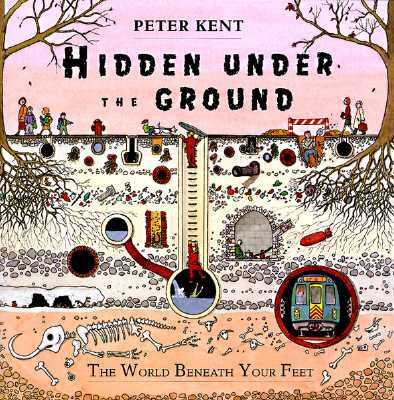
by Peter Kent
Book list Gr. 3^-6. Although the text may not go very deep, the illustrations certainly do, as Kent takes us to places both literal and figurative beneath our Nikes. On each double-page spread he treats a kind of underground with brief introductory text, a sidebar of interesting factoids, and something to look for (answers are at the back). For example, "Animal Underworld" illustrates moles, badgers, foxes, and rabbits and asks how many rabbits are in the picture. Kent travels from the mystical underworld (a hell that owes something to Bosch and Dante) to medieval dungeons to a village of caves in Sicily to city sewers, subways, and cables. Mining and the bunkers of the cold war are also noted. Digging tools, from the mole's jaws to tunnel borers, are illustrated, and so are a few "subterranean celebrities" such as Thelma Ursula Beatrice Eleanor (note the initials), who was born on the Bakerloo Underground line in London. British and American measures are given. --GraceAnne A. DeCandido From Booklist, Copyright © American Library Association. Used with permission. Publishers Weekly Kent (A Slice Through a City) poses a fascinating questionÄjust what, exactly, lies underground beneath our feet?Äand gives a playful, if somewhat slapdash, answer in this picture book for older readers. He begins with a brief introduction that discusses why humans throughout the ages have tunneled under the earth and a page of one-paragraph descriptions of "Subterranean Celebrities" (both historical and mythological). What follows are 11 double-page spreads that present details about underground environments that have existed for centuries (animal and human homes, tombs, mines and dungeonsÄeven legendary "Afterlife Underworlds"), as well as more modern subways, city service systems and nuclear bomb bunkers. Many of the spreads' brief stage-setting introductions include overly broad generalizations and the occasional awkward phrase, and history buffs may wish for dates in several of the factoids (e.g., on the same page, King Wenceslaus's life span is given [903-935], but the completion date of the Mount Cenis railroad tunnel is not). But curious readers are likely to forgive these flaws in their eagerness to pore over Kent's humorously detailed, small-scale subterranean scenes. He invites readers' scrutiny with each spread's picture search ("Rabbits breed like... rabbits. How many rabbits can you find in this picture?") and offers answers at the book's close. Captions and sidebars provide factual tidbits both informative and amusing. Ages 8-12. (Sept.) Copyright © Reed Business Information, a division of Reed Elsevier Inc. All rights reserved. School Library Journal Gr 3-5-This easily read and highly pictorial work on a variety of underground landscapes suffers from a flaw common to many foreign imports when it comes to animal life. Similar-looking species may have widely divergent lifestyles when an ocean intervenes. The segment on the "Animal Underworld" depicts a colony of European rabbits (Oryctolagus) living in a communal burrow, or warren, and Eurasian badgers (Meles) in a clannish tunnel system called a sett. American badgers (Taxidea) are loners except during the mating season, and most American rabbits (Sylvilagus) live their entire lives above ground. Aside from that problematical display, Kent's cartoon drawings are appealing and informative and contain Waldoesque elements of searching for rats in a dungeon and enumerating the kings, queens, and knights in a Medieval European vision of hell. Sidebars present extra information on such topics as "Grave Facts" and "Safety in Shelters" (where there is a caption error). While certainly fun to peruse and aimed at a much younger audience than Christie McFall's straightforward America Underground (Cobblehill, 1992; o.p.) and David Macaulay's more tightly focused, top-notch Underground (Houghton, 1976), the variances in the section on subterranean animal life and such overly simplified statements as cave creatures are "...blind because there is no light, so they don't need eyes..." should give one pause.-Patricia Manning, formerly at Eastchester Public Library, NY Copyright © Reed Business Information, a division of Reed Elsevier Inc. All rights reserved. |